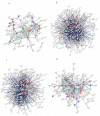A Panel of Eight miRNAs Is Deregulated in HTLV-2 Infected PBMCs and BJABGu Cell Line
- PMID: 35886938
- PMCID: PMC9320395
- DOI: 10.3390/ijms23147583
A Panel of Eight miRNAs Is Deregulated in HTLV-2 Infected PBMCs and BJABGu Cell Line
Abstract
Despite human T-cell leukemia virus type 1 (HTLV-1) and HTLV-2 being retroviruses closely related at a genomic level, HTLV-2 differs from HTLV-1 in terms of pathogenicity in both single infection and coinfection contexts. Moreover, the HTLV-2 association with clinical outcomes is still debated and several mechanisms underlying HTLV-2 infection remain unexplored as well. Cellular miRNAs are key factors in the post-transcriptional regulation of gene expression and they are known to be potential targets for several pathogens to control the host microenvironment and, in particular, escape immune responses. Here, we identified a HTLV-2-related signature of eight miRNAs (miR-125a-3p, miR-381-3p, miR-502-5p, miR-708-5p, miR-548d-5p, miR-548c-5p, miR-1-3p, and miR-511-5p) in both HTLV-2 infected PBMC and BJABGu cell lines. Altered miRNA expression patterns were correlated with the impairment of Th cell differentiation and signaling pathways driven by cytokines and transcriptional factors such as the Runt-related transcription factor (RUNX) family members. Specifically, we demonstrated that the RUNX2 protein was significantly more expressed in the presence of Tax-2 compared with Tax-1 in an in vitro cell model. To the best of our knowledge, these data represent the first contribution to elucidating the HTLV-2 mediated alteration of host cell miRNA profiles that may impact on HTLV-2 replication and persistent infection.
Keywords: HTLV-2; RUNX; Tax; cell signaling pathways; host-virus interactions; miRNA.
Conflict of interest statement
The authors declare no conflict of interest.
Figures





Similar articles
-
Circulating miR-29c, miR-30c, miR-193a-5p and miR-885-5p: Novel potential biomarkers for HTLV-1 infection diagnosis.Infect Genet Evol. 2019 Oct;74:103938. doi: 10.1016/j.meegid.2019.103938. Epub 2019 Jun 23. Infect Genet Evol. 2019. PMID: 31242452
-
miR-28-3p is a cellular restriction factor that inhibits human T cell leukemia virus, type 1 (HTLV-1) replication and virus infection.J Biol Chem. 2015 Feb 27;290(9):5381-90. doi: 10.1074/jbc.M114.626325. Epub 2015 Jan 7. J Biol Chem. 2015. PMID: 25568327 Free PMC article.
-
MicroRNA miR-146a is induced by HTLV-1 tax and increases the growth of HTLV-1-infected T-cells.Int J Cancer. 2012 May 15;130(10):2300-9. doi: 10.1002/ijc.25115. Epub 2009 Dec 16. Int J Cancer. 2012. PMID: 20017139
-
Silencers of HTLV-1 and HTLV-2: the pX-encoded latency-maintenance factors.Retrovirology. 2019 Sep 6;16(1):25. doi: 10.1186/s12977-019-0487-9. Retrovirology. 2019. PMID: 31492165 Free PMC article. Review.
-
Regulation of the MIR155 host gene in physiological and pathological processes.Gene. 2013 Dec 10;532(1):1-12. doi: 10.1016/j.gene.2012.12.009. Epub 2012 Dec 14. Gene. 2013. PMID: 23246696 Review.
Cited by
-
HTLV-1 and HTLV-2 infections significantly alter small RNA expression in asymptomatic carriers.Front Med (Lausanne). 2025 Feb 17;12:1547712. doi: 10.3389/fmed.2025.1547712. eCollection 2025. Front Med (Lausanne). 2025. PMID: 40034383 Free PMC article.
-
Quantitative proteomic analysis of PK-15 cells infected with porcine circovirus type 3 using 4D-DIA approach.Vet Res Commun. 2024 Dec;48(6):3593-3603. doi: 10.1007/s11259-024-10501-1. Epub 2024 Aug 22. Vet Res Commun. 2024. PMID: 39172195 Free PMC article.
References
MeSH terms
Substances
LinkOut - more resources
Full Text Sources

